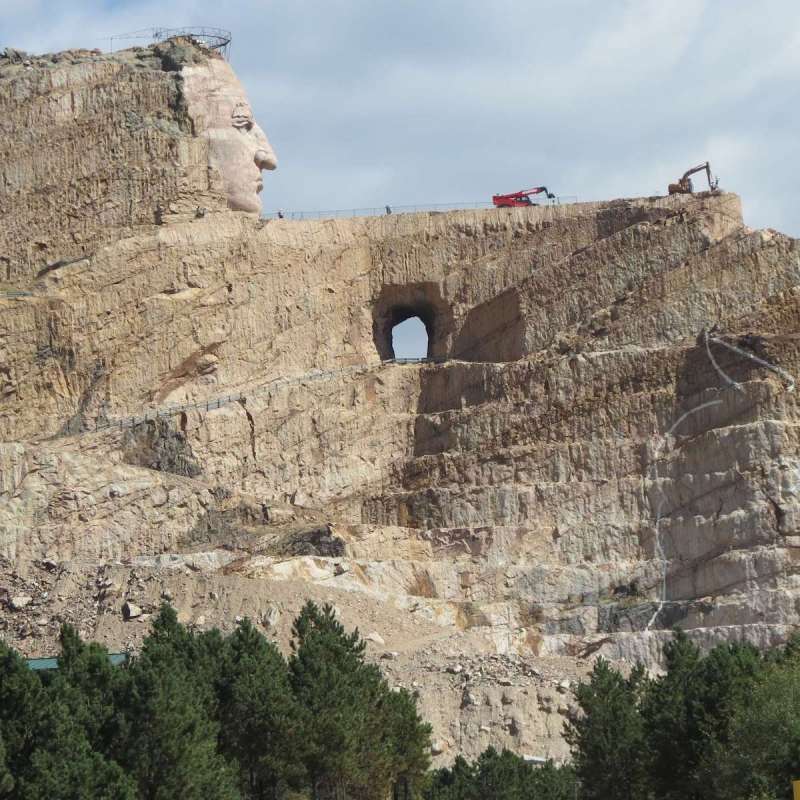
They gather for ceremonies, from prayers to powwows. Replacing Columbus Day around the United States, Indigenous Peoples’ Day recognizes the history and successes of the country’s first people. While not an official federal holiday, more states, cities, and even colleges have either replaced Columbus Day with Indigenous Peoples’ Day or, like my state of Nebraska, share the day between the two. As more places observe Indigenous Peoples’ Day, events include dances, speeches, and lunches.
Videos by TravelAwaits
Since Christopher Columbus landed in the Caribbean in 1492, his “discovery” of America has been incorrectly taught in school. Columbus never stepped on North American soil. It’s believed that Viking Leif Erikson led an expedition long before Columbus set sail on the ocean blue.
As we observe Indigenous Peoples’ Day, I thought, “What would I tell someone who asked me about Native American history?” With more than 570 federally recognized tribes, we can’t pigeonhole or stereotype Indigenous people. Like European and Asian cultures, each has its own traditions, language, and stories. However, if I had to offer an abridged history of Indigenous people in the United States, here are nine notable Native Americans to learn more about.

1. Chief Standing Bear
In 1877, the Ponca tribe was forcibly moved from its homeland in northeast Nebraska, walking 600 miles in more than 50 days. Nine tribal members died during the move. After their relocation to a reservation in Oklahoma, then known as Indian Territory, Chief Standing Bear’s son died. Before this, he asked his father to bury him in their homeland. Standing Bear and a few others left the reservation without permission to begin the trek north. They were eventually captured and sent to Fort Omaha in Nebraska. It was here that Chief Standing Bear would make history.
Befriending Standing Bear, a local journalist engaged an attorney, and they sued the federal government, claiming that Standing Bear had the right to travel to his homeland. General George Crook, the fort’s commander and a defendant, testified on behalf of Standing Bear. During the trial, Standing Bear testified that, while his skin tone was different, if he pricked his hand, his blood would be red, the same as the White people sitting in judgment. In a landmark decision, Chief Standing Bear won the first civil rights lawsuit in Native American history, when the trial judge ruled that Native Americans were “persons” under the law. It was the first time in American history that someone officially recognized Native Americans as human. Standing Bear and his group were freed. Chief Standing Bear is believed to be buried in an unmarked grave near the Niobrara River in his homeland. The chief is honored with statues in Statuary Hall in the United States Congress, along Centennial Mall in Lincoln, Nebraska, and at the Ponca tribal grounds near Niobrara.

2. Crazy Horse
Most Americans may know of Crazy Horse because of the memorial slowly being constructed in South Dakota. The memorial, a few miles from Mount Rushmore, dwarfs the national monument and is being built without government funding, thus the reason for the slow process. But, Crazy Horse is more than a mountainside sculpture. Crazy Horse, a Lakota (Sioux), was among the leaders of the Native American warriors taking on Colonel George Custer and the Seventh Cavalry at the Battle of Greasy Grass (the Indigenous name for the Battle of Little Bighorn). Crazy Horse would likely be considered eccentric today, as he didn’t follow traditional customs and embraced a different fighting style than other Native leaders. After helping lead the biggest victory in Native American history at Little Bighorn, Crazy Horse refused to flee to Canada to avoid capture by the military or surrender to soldiers. Instead, he led a band of fighters on continued raids against the American military. After about a year, he eventually did surrender. In May 1877, while at Fort Robinson in northwest Nebraska, a soldier stabbed him with a bayonet. Questions surround his death, whether it was self-defense by the soldier or murder.
3. Wilma Mankiller
The first woman Principal Chief of the Cherokee Nation, Wilma Mankiller spent her life fighting for civil rights not just for her nation, but also for women. Inspired by the 1969 occupation of Alcatraz Island by the Indians of All Tribes, she worked to improve living conditions for Native Americans. Returning to Oklahoma after having lived on the West Coast, she served as Deputy Principal Chief before being elected in 1987 to lead the Cherokee. Mankiller served for 10 years, working to improve housing and education for tribal members. She received the Presidential Medal of Honor in 1998. Mankiller passed away in 2010 at the age of 64.

4. Jim Thorpe
Considered the best athlete of the first half of the 20th century, Jim Thorpe, a member of the Sac and Fox Nation, won gold medals in the decathlon and pentathlon at the 1912 Olympics in Stockholm, Sweden. However, his medals were revoked because he was paid to play in semi-pro baseball games a few years earlier. His medals were eventually returned to his family several years after his death. During his sports career, Thorpe played baseball from 1913–1919 for the New York Giants, Cincinnati, and Boston in the National League. He also excelled in professional football, playing for the Canton Bulldogs, among other teams, during a 12-year career in the American Professional Football Association, predating the National Football League. Thorpe also coached, where he accumulated a 14-25-2 record over 10 years. He was named to the Pro Football Hall of Fame in 1963.
5. Maria Tallchief
Maria Tallchief dreamed of being a dancer. Born in Oklahoma in 1925, a year after Native Americans were granted American citizenship, Tallchief, an Osage Nation citizen, would go on to become America’s first prima ballerina. She demonstrated a talent for dance early in her life. The family moved to California in hopes of helping her develop a career in dance. Drawn to ballet, Tallchief headed to New York City after finishing high school. After a few years of rejection, based on her ethnicity, Tallchief joined a Russian dance company in New York. After the lead dancer left the company, Tallchief replaced her. It would be the first of several standout performances, including becoming the first American ballerina to dance with the Paris Opera Ballet. She was also the first American to perform at Moscow’s Bolshoi Theater, starring in The Nutcracker. After retiring as a dancer, she started the Chicago Dance Company. Tallchief died in 2013 at the age of 88.

6. Senator Daniel K. Inouye
Born in 1924, more than 35 years before his native Hawaii would be granted statehood, Daniel K. Inouye seemed destined for greatness. During World War II, when Asian Americans were forced to spend the war in internment camps throughout the western United States, Inouye served in the U.S. Army. While his unit was one of the most decorated in the war, Inouye, who lost an arm in battle, also received the Medal of Honor, Distinguished Service Cross, Bronze Star, and Purple Heart. A graduate of George Washington University’s law school, Inouye joined Hawaii’s first elected Congressional representatives following Hawaii’s admittance into statehood in 1960. Two years later, he was elected to the U.S. Senate, serving until his death in 2012. He served on committees investigating Watergate and the Iran-Contra weapons deal. Inouye was posthumously awarded the Presidential Medal of Freedom in 2013, making him the first American to receive both the Medal of Honor and the presidential honor.

7. Richard Oakes
Richard Oakes, a Mohawk citizen from New York, led a group of Native Americans in the 1969 occupation of Alcatraz Island. Oakes played a role in developing one of the nation’s first Native American studies programs at San Francisco State University. While the Alcatraz occupation by the Indians of All Tribes lasted about 18 months, Oakes’s time on the island was cut short following the death of his daughter. He continued his campaign for equality and social justice, taking on businesses to reclaim Indigenous land in northern California. He was shot and killed by another man in 1972, who claimed self-defense; Oakes was unarmed. His story is told in the biography A Journey to Freedom: Richard Oakes, Alcatraz, and the Red Power Movement by Kent Blansett, a professor at Kansas University.
8. Susan La Flesche Picotte And Charles Eastman
While citizens of different tribes, Susan La Flesche Picotte and Charles Eastman are connected in history as the first Native Americans to graduate from medical school. La Flesche Picotte was a member of the Omaha tribe and graduated from the Woman’s Medical College of Pennsylvania in 1889. Less than a year later, Eastman, whose Santee Dakota (Sioux) name was Ohiyesa (The Winner), graduated from Boston University in 1890. Picotte was determined to become a doctor after witnessing a White doctor refuse to treat a sick Native American woman. She dedicated her career to serving the needs of both Native and non-Native patients. She later opened a hospital in Walthill, Nebraska. Eastman served as a physician at the Crow Creek agency in South Dakota, and helped people wounded by soldiers at the Battle of Wounded Knee in 1890. He also represented the Sioux Nation in Washington, D.C.

9. Charles Curtis
Charles Curtis was the first person of color to serve as Vice President of the United States when he joined Herbert Hoover on the 1928 Republican Party ballot. Curtis, the son of a Kaw woman from Kansas and a White man, spent his youth living both in Topeka and on the Kaw reservation. As a boy, Curtis loved racing horses and was considered the fastest horse racer. Dreaming of a career as a jockey, Curtis’s paternal grandmother had other ideas, making the youth attend school in Topeka. As an adult, Curtis excelled in politics. More than 30 years before Native Americans were granted American citizenship, Curtis was elected to the U.S. House of Representatives in 1892, where he served for 14 years. In 1906, he was elected to the U.S. Senate, serving until his selection as the 1928 VP candidate. Curtis rose through the Senate ranks to become the first ever Senate Majority Leader in history. His political career ended after the 1932 campaign when Hoover dropped him (they didn’t like each other). Hoover lost. Curtis practiced law in Washington, D.C., until dying from a heart attack in 1936.
